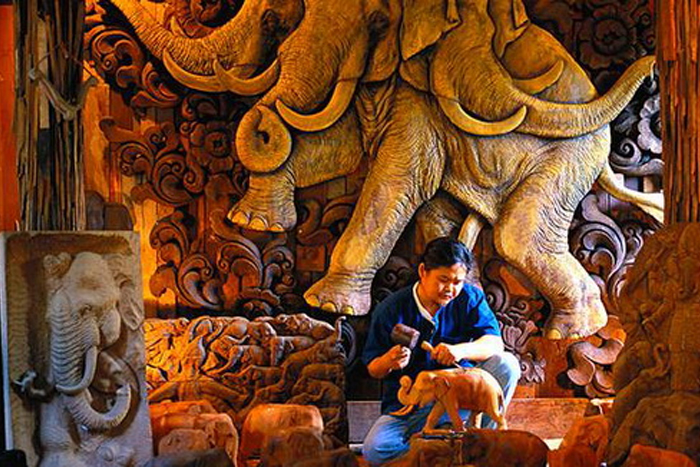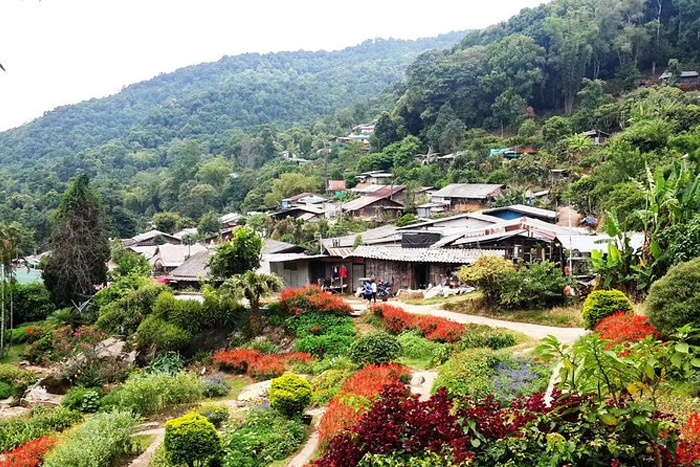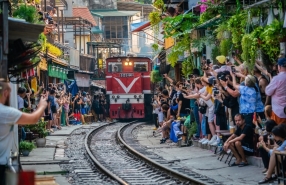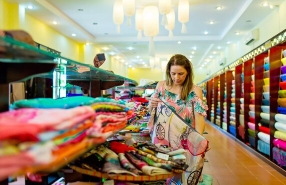What to do in Chiang Mai? The
handicraft villages in Chiang Mai are must-see destinations for travelers in search of authenticity and cultural discovery. These traditional communities showcase the rich artistic heritage of Northern Thailand from hand-painted umbrellas and intricately woven silk to ancient pottery and detailed wood carvings. A visit to these villages allows you to meet skilled artisans, observe live demonstrations, and bring home unique handmade souvenirs. Whether you're exploring as a couple, with family, or on your own, this immersive experience offers more than just shopping - it’s a meaningful encounter with local tradition and craftsmanship. In this guide, uncover the best handicraft villages to visit around Chiang Mai and learn when to go for the most rewarding experience.
I. Why visit the handicraft villages in Chiang Mai and its surroundings?
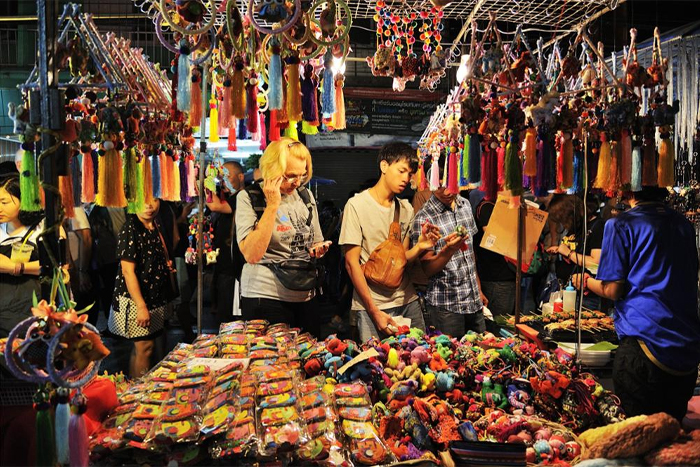
1. A truly authentic cultural experience
The handicraft villages in Chiang Mai and its surroundings offer travelers a deep and genuine insight into the heart of Thai culture. Unlike urban tourist markets, these villages feature handmade creations crafted with care and tradition. Visitors can witness the artistry behind hand-painted umbrellas, ancient pottery, silk weaving, and detailed woodcarving - all made before their eyes.
2. Preserving unique traditional skills
These villages are guardians of ancient techniques passed down through generations. By visiting them, you help preserve a living heritage that is increasingly threatened by industrialization and mass tourism. Many artisans even welcome visitors to join in live demonstrations or hands-on workshops, making the experience even more immersive.
3. Ethical and responsible tourism
Buying directly from artisans means supporting the local economy fairly and sustainably. It also ensures that you're purchasing authentic, high-quality handicrafts, far from the mass-produced items found in generic souvenir shops. This kind of sustainable tourism promotes meaningful connections and a more respectful way of traveling.
4. A memorable and emotional journey
Meeting the artisan, hearing their story, and understanding their craft turns every purchase into a personal memory. Each handcrafted item becomes more than just a souvenir - it’s a reflection of a unique moment and a transformative travel experience that stays with you long after your trip.
II. Top 6 must-visit handicraft villages in Chiang Mai and nearby areas
1. Bo Sang - The village of hand-painted umbrellas
Bo Sang is one of the most iconic handicraft villages in Chiang Mai. Renowned for its beautiful handmade umbrellas crafted from Sa paper, this colorful village offers a poetic and immersive experience. Each umbrella is carefully hand-painted with floral or animal motifs inspired by local Thai culture. Visitors can observe artisans at work, explore open studios, and even join a hands-on painting workshop. It's also a great place to shop for high-quality, handmade souvenirs at affordable prices. The highlight of the year is the Bo Sang Umbrella Festival, held every January, featuring vibrant parades, umbrella competitions, and traditional cultural performances in a festive village atmosphere.
2. San Kamphaeng - The hub of silk and ceramics
Located just 13 kilometers east of Chiang Mai, San Kamphaeng is a major handicraft center in Northern Thailand. It is especially famous for its handwoven silk. Visitors can observe the entire silk-making process from cocoon to finished textile in local workshops. The village is also home to artisans specializing in ceramics, lacquerware, silver jewelry, and wood carving. Numerous galleries display both traditional and contemporary crafts. During December or Thai New Year (Songkran), San Kamphaeng hosts artisan fairs featuring demonstrations, discounted items, and cultural performances open to the public.
3. Ban Tawai - Thailand’s wood carving capital
Roughly 15 kilometers south of Chiang Mai lies Ban Tawai, considered Thailand’s capital of wood carving. This handicraft village is a treasure trove for collectors and lovers of handmade furniture, Buddhist décor, and intricately carved teak panels. Visitors can stroll through countless galleries and open-air studios, where artists work in real time. Custom orders are also available directly from artisans. Each year, the Ban Tawai Handicraft Fair attracts art lovers from around the world. During the event, products are offered at reduced prices, and the village comes alive with traditional dance performances, live woodcarving, and exhibitions.
4. Muang Kung - Traditional pottery village
Tucked away in Hang Dong district, Muang Kung is a peaceful village known for its traditional pottery. Unlike more commercialized destinations, Muang Kung maintains a calm and authentic charm. Local artisans create terracotta jars, rice pots, and decorative clay pieces using ancestral techniques. Visitors can watch master potters at work, try pottery wheels, and purchase handmade items directly from the source. Each September or October, the village hosts the Muang Kung Pottery Days, a local festival featuring pottery workshops, exhibitions, and artisan markets in a warm and friendly atmosphere.
5. Doi Pui - Hmong Handicrafts in the mountains
Nestled in the hills near Doi Suthep-Pui National Park, Doi Pui is home to a Hmong ethnic community renowned for its intricate embroidery and colorful handicrafts. This highland village offers a rich cultural experience amid scenic mountain landscapes and living traditions. Here, visitors can browse traditional embroidered garments, handmade bags, jewelry, and complex textile patterns. A small museum dedicated to Hmong culture is also open to the public, and you can enjoy a cup of locally grown tea with panoramic views. Every year, the Hmong New Year Festival brings the village to life with dances, songs, and traditional games, providing a festive and authentic insight into this vibrant culture.
6. Wat Ket - Chiang Mai’s artistic and alternative district
Unlike rural villages, Wat Ket is an artistic district located along the Ping River in downtown Chiang Mai. This unique area brings together art galleries, bohemian cafés, boutique design shops, and contemporary artisan studios. It’s the perfect place to explore a modern, urban side of Thai craftsmanship, often infused with graphic design, ethical fashion, and upcycled creations. The Wat Ket Museum also houses a fascinating collection of antiques and historical photographs from Chiang Mai. Every December, Wat Ket becomes a central venue for the Chiang Mai Design Week, a major creative event featuring exhibitions, designer markets, and innovative public installations by both local and international artists.
III. Where to buy authentic handicrafts in Chiang Mai?
Chiang Mai is renowned for its rich and diverse handicraft traditions, but knowing where to buy authentic products is key to avoiding counterfeits or mass-produced items. Here are some trusted recommendations to help you bring home unique, ethical, and high-quality souvenirs.
- 🛍️ Buy directly in the handicraft villages in Chiang Mai: There’s nothing better than purchasing directly from the artisans themselves. By visiting handicraft villages such as Bo Sang, San Kamphaeng, or Ban Tawai, you can witness the creation process, ask questions, and choose from handcrafted items often signed by their maker. This not only guarantees authenticity but also supports local artisan families in a fair and meaningful way.
- 🧺 Visit traditional markets: Markets like Warorot Market (Kad Luang) and the Sunday Night Market are ideal spots to discover a variety of handcrafted goods at reasonable prices. However, it's important to check the origin of each item. Look for stalls where artisans are present and can explain their techniques - this is usually a good sign that the product is truly handmade and locally sourced.
IV. Practical tips for visiting the handicraft villages in Chiang Mai
To help you explore the handicraft villages in Chiang Mai and its surroundings efficiently, it’s useful to visualize their locations and plan your itinerary accordingly. Below is a quick guide to key villages and their distances from the city center.
🧭 Main villages to locate on your map:
📍 Bo Sang - 9 km east of Chiang Mai: ideal for a half-day cultural visit.
📍 San Kamphaeng - 13 km east: can easily be combined with Bo Sang in one day.
📍 Ban Tawai - 15 km south: best known for wood carving; perfect for a morning visit.
📍 Muang Kung - 18 km southwest: calm and authentic, great for a quiet half-day.
📍 Doi Pui - 20 km northwest: fits well into an excursion to Doi Suthep.
📍 Wat Ket - Located within the city near the Ping River: accessible by foot or bicycle.
💡 Travel tip: To make the most of your day, consider renting a scooter or booking a private guided tour that allows you to visit 2–3 villages in the same region. Some local agencies offer themed circuits that combine handicrafts with food experiences or nature discovery.
👉 For example, Autour Asia offers tailor-made excursions focused on meeting local artisans, including comfortable transportation, a English-speaking guide, and participation in real craft workshops. It’s a great option for exploring the handicraft villages in Chiang Mai with ease, cultural depth, and a personalized itinerary.
Exploring the handicraft villages in Chiang Mai is a chance to experience the true heart of Northern Thailand. These living communities preserve meaningful traditions where every handmade object tells a story, and every encounter leaves a lasting impression. From hand-painted umbrellas and woven silk to pottery and wood carving, you’ll enjoy a cultural immersion far from standard tourist routes.
✨To enjoy a truly complete and enriching experience in Chiang Mai, don’t hesitate to contact
Autour Asia, a reputable
Thailand travel agency. Their team will help you plan your visits with authenticity, care, and cultural insight.👉 Start planning your journey today and discover the soul of Thai craftsmanship.
Sandrine Boursier
5.0
Excellent
Can I visit Chiang Mai’s handicraft villages in one day?
Yes, it is absolutely possible to visit several handicraft villages in Chiang Mai and its surroundings in a single day, as long as you plan your itinerary well. Some villages are located in the same area, such as Bo Sang and San Kamphaeng to the east, or Ban Tawai and Muang Kung to the south, which helps optimize travel time. For a comfortable and enriching experience, it’s recommended to rent a scooter if you're confident navigating on your own, or to book a private tour with a local agency. This way, you can explore 2 to 3 villages while enjoying cultural insights and taking your time in artisan workshops.
Renaud Belair
5.0
Excellent
What is the best time to visit the handicraft villages in Chiang Mai?
The best time to visit the handicraft villages in Chiang Mai and its surroundings is between November and February, during the dry season. During this period, the weather is mild and pleasant, with temperatures ranging from 18°C to 28°C, making outdoor walks especially enjoyable. It also coincides with major local craft festivals, such as the Bo Sang Umbrella Festival in January and the Chiang Mai Design Week in December, offering visitors a more vibrant and immersive experience in the world of local artisans. Traveling during this season allows you to fully enjoy the workshops, live demonstrations, and cultural encounters without the discomfort of heat or rain.
Kevin Owens
5.0
Excellent
Which are the most well-known handicraft villages in Chiang Mai?
Among the many handicraft villages in Chiang Mai and its surroundings, several stand out for their unique craftsmanship and strong reputation. Bo Sang is perhaps the most famous, known for its hand-painted umbrellas, a colorful symbol of the region. Nearby, San Kamphaeng specializes in handwoven silk, ceramics, and lacquerware. To the south of the city, Ban Tawai is recognized as Thailand’s wood carving capital, attracting lovers of handcrafted furniture and décor. More discreet but equally authentic, Muang Kung is a traditional pottery village where visitors can discover ancient clay-shaping techniques. Finally, located in the mountains, Doi Pui offers a glimpse into Hmong culture with its traditional embroidery, handmade jewelry, and colorful garments.



